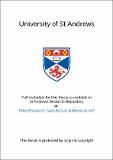Files in this item
The best Pompeii in Scotland : 'A series of calotype views of St. Andrews' by David Octavius Hill and Robert Adamson
Item metadata
| dc.contributor.advisor | Smith, Graham, 1942- | en |
| dc.contributor.author | Schoonhoven, Anne Marie | en |
| dc.coverage.spatial | vi, 125 p, 125 p of plates. | en |
| dc.date.accessioned | 2021-04-08T08:59:16Z | |
| dc.date.available | 2021-04-08T08:59:16Z | |
| dc.date.issued | 2002 | |
| dc.identifier.uri | https://hdl.handle.net/10023/21895 | |
| dc.description.abstract | Photography had some of its earliest applications in Scotland, at St. Andrews, as a result of the friendship and collaboration between Sir David Brewster, Principal of the United College of St Leonard and St Salvator, and William Henry Fox Talbot, inventor of the photogenic drawing and calotype processes. Given the limitations of the new art of photography in its early stages of development, stable objects were critical to the success of its images. Architectural monuments therefore presented themselves as interesting and cooperative subjects. Moreover, with this choice of subject, photography joined a pre-existing tradition of illustrating famous architectural monuments, a tradition for which there was already a popular market and a set of established conventions governing how buildings were to be recorded. This thesis investigates the manner in which the calotype followed or expanded upon previously established conventions of documenting architecture. More specifically, it is concerned to explore the extent to which the tradition of photography in St. Andrews reinforced the prominence of particular buildings and influenced the way in which these buildings were depicted. It will do so through a consideration of the technical aspects of the calotype process, and through a detailed investigation of A Series of Calotype Views of St. Andrews, by David Octavius Hill and Robert Adamson. This album is one of the earliest instances of, and an elaborate attempt at, recording prominent buildings using the calotype process. The thesis will compare these photographic views with the tradition of pre-photographic representations of the same subjects, to see what similarities exist, and where the photographic views depart from this tradition. | en |
| dc.language.iso | en | en |
| dc.publisher | University of St Andrews | en |
| dc.subject.lcc | TR651.H5A3S3 | |
| dc.subject.lcsh | Hill, David Octavius, 1802-1870 | en |
| dc.subject.lcsh | Adamson, Robert, 1821-1848 | en |
| dc.subject.lcsh | St Andrews (Scotland)--Pictorial works | en |
| dc.title | The best Pompeii in Scotland : 'A series of calotype views of St. Andrews' by David Octavius Hill and Robert Adamson | en |
| dc.type | Thesis | en |
| dc.type.qualificationlevel | Doctoral | en |
| dc.type.qualificationname | MPhil Master of Philosophy | en |
| dc.publisher.institution | The University of St Andrews | en |
This item appears in the following Collection(s)
Items in the St Andrews Research Repository are protected by copyright, with all rights reserved, unless otherwise indicated.

